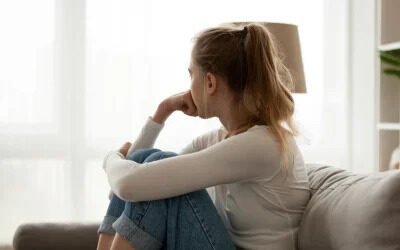8 million people per year suffer from post traumatic stress  disorder. This makes up 20% of trauma survivors that then carry their negative experience with them inside the cells of their body.
disorder. This makes up 20% of trauma survivors that then carry their negative experience with them inside the cells of their body.
While it may seem far fetched to hear that trauma can become lodged inside of us, that’s precisely what happens.
Not every trauma victim will carry their wounds long term, however, unless they have a strong support system, a resilient mindset, and access to resources, it’s likely for them to develop symptoms of PTSD.
Medication and therapy are effective forms of treatment for PTSD victims, yet they only go so far.
Exercise has many benefits when it comes to healing symptoms of post traumatic stress disorder. Read on to find out just how moving your body can heal those wounds one workout at a time.
What Is Post-Traumatic Stress Disorder?
Post-traumatic stress disorder is a mental disorder in which a person struggles to recover from experiencing or witnessing a traumatic event. When people hear the word “PTSD” oftentimes their minds quickly jump to a soldier returning home from war only to experience distressing flashbacks of combat.
While this is accurate, other circumstances can cause a person to develop PTSD.
Other events that can trigger PTSD include, but are not limited to:
- A serious accident
- Childhood abuse
- Sexual assault
- Domestic violence
- Witnessing or experiencing a violent crime
- Natural disasters
When our bodies experience a traumatic event, our brains can quite literally change. At the fundamental level, PTSD can damage the parts of our brain associated with regulation of emotions and fear response.
In addition, areas of our brain may in turn release unwanted flashbacks when triggered by a certain stimulus (i.e: a veteran hearing fireworks).
5 Ways Exercise Can Benefit Patients With PTSD:

- Exercise Improves Anxiety Levels.
- Exercise Improves Symptoms Of Depression.
- Exercise Increases Determination and Self-Confidence.
- Exercise Increases Respiratory Sinus Arrhythmia.
- Exercise Doesn’t Require A Patient To Relive Their Trauma.
Exercise Improves Anxiety Levels:
Post-traumatic stress disorder can disrupt every area of a person’s life. Since PTSD is a disorder stemming from a particularly stressful, frightening, or disturbing event, it’s not surprising that anxiety levels are elevated in victims of trauma.
On average, 1 in 6 patients with PTSD will develop generalized anxiety disorder.
This can leave a person on the edge of their seat constantly, fearing for the worst. Oftentimes this can include intrusive thoughts about the traumatic event recurring, or excessive worry about what may trigger an onset of a PTSD attack.
When our bodies exercise, anxiety levels ease up in a variety of ways:
- Can distract us from intrusive thinking
- Decreases muscle tension – a common physical symptom of anxiety
- An increase in heart rate releases anti-anxiety neurochemicals such as serotonin and endocannabinoids.
- Activates and strengthens our frontal brain regions responsible for reacting to real or imagined threats
In addition, exercise can help ease symptoms of anxiety long term by building up resiliency resources to fight off mood swings.
Exercise Improves Symptoms Of Depression:
Depression is an incredibly common experience after experiencing a  traumatic event. Symptoms such as low mood, irritability, lack of interest in daily activities, and a sense of hopelessness often manifest weeks, or even months later.
traumatic event. Symptoms such as low mood, irritability, lack of interest in daily activities, and a sense of hopelessness often manifest weeks, or even months later.
When it comes to PTSD and depression, an alarming 75% of patients seeking help report a history of traumatic events such as abuse or assault.
Oftentimes a person experiencing PTSD may feel hopeless in the fact they cannot change what happened in the past. This can lead to a dark hole of despair. Thankfully, our brains are able to be changed.
Exercise is one way in which depression symptoms can be alleviated in trauma survivors:
- Can improve sleep (in patients with PTSD, nightmares, and insomnia are common symptoms)
- Endorphins – the body’s ‘happy chemicals’ are released
- Neurotrophic proteins are released causing nerve cells to regenerate and repair
- The hippocampus (the brain region associated with mood) expands and becomes stronger
Exercise Increases Determination and Self-Confidence:
For PTSD patients, their traumatic event can often derail their entire sense of identity. This is particularly true for survivors of rape or sexual assault. Many victims may feel as though their bodies have been violated to the point they no longer feel worthy. Trauma may cause a person to view themselves in a negative light and give up any goals or dreams they once had.
For wartime trauma, a soldier returning home may feel overwhelming shame or guilt for actions taken overseas and this can cause low self-esteem and a decrease in self-confidence.
Through exercise, trauma victims can begin to find their identity again. Working out requires self promises and goal achievement. These milestones can prove extraordinarily beneficial for a person suffering from PTSD. By keeping up with a workout routine, their determination and self-confidence can rebuild themselves from the ground up.
Exercise Increases Respiratory Sinus Arrhythmia:
In the simplest terms, respiratory sinus arrhythmia (RSA) is the regulation of heartbeat with each breath taken. RSA is particularly important as it signifies the health of blood circulation in the body. Measuring levels of RSA is a form of biofeedback, a technique used to measure the functions of a patient’s body in conjunction with their mental health.
Healthy, functioning RSA levels enable a person to self-regulate effectively, as well as balance mood and energy dips.
Low resting RSA is seen in many patients suffering from stress, mental illnesses, and physical ailments. Consequently, low RSA is seen in many patients with PTSD.
Through exercise, trauma survivors increase their heart rates which in turn stabilize RSA levels. These stable RSA levels can equip patients with PTSD the ability to regulate their emotions, fears, and worries efficiently.
Exercise Doesn’t Require A Patient To Relive Their Trauma:
Exposure therapy used for decades has proven to be an incredibly effective tool in overcoming both phobias and PTSD. However, for many trauma survivors, this is one of the biggest reasons for avoiding treatment altogether.
For patients with PTSD, exercise provides a way to recover from trauma symptoms without having to relive the past.
While exposure therapy is still at the forefront of PTSD management, it’s safe to say exercise can be just as beneficial, without making a victim confront their most hurtful, vulnerable moments.
So, Is Exercise Helpful For People With PTSD?
 All in all, it’s safe to say that exercise is an incredibly useful tool in dealing with the negative emotions, harmful thinking patterns, and physical ailments associated with PTSD.
All in all, it’s safe to say that exercise is an incredibly useful tool in dealing with the negative emotions, harmful thinking patterns, and physical ailments associated with PTSD.
Not only is a person able to regain their sense of self-accomplishment, they’re able to engage in better sleep, allowing the body to recover from a consistent state of ‘fight or flight’.
PTSD wrecks havoc within the brain and exercise can reboot and regrow the neurotransmitters that were damaged from past trauma.
With all of these benefits, there’s no question that exercise needs a crucial place in PTSD treatment and recovery.
Click here for more on Trauma Therapy.
Resources:
- https://www.therecoveryvillage.com/mental-health/ptsd/related/ptsd-statistics/#:~:text=20%20percent%20of%20people%20who,PTSD%20in%20a%20given%20year
- https://www.health.harvard.edu/blog/can-exercise-help-treat-anxiety-2019102418096
- https://www.health.harvard.edu/mind-and-mood/exercise-is-an-all-natural-treatment-to-fight-depression
- https://www.ncbi.nlm.nih.gov/pmc/articles/PMC4677006/
- https://www.intechopen.com/chapters/63530
- https://blog.nasm.org/exercise-and-post-traumatic-stress-disorder

